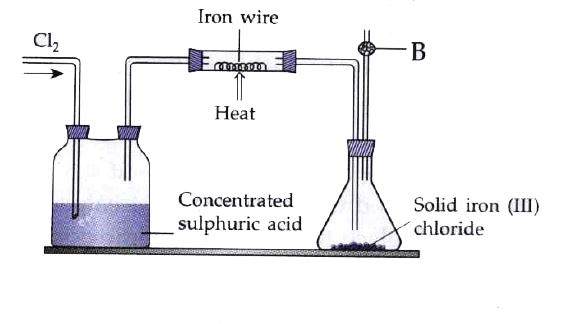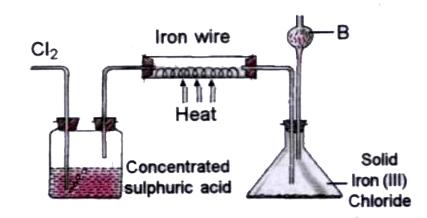In the preparation of iron (III) chloride by the action of dry chlorine on hot iron, heating is discontinued once the reaction starts. Give reason.
To prepare iron (III) chloride (FeCl3) by the action of dry chlorine on hot iron, we follow these steps:
1. Preparation of the Setup: Begin by taking powdered iron in a combustion tube. This tube is suitable for conducting the reaction as it can withstand high temperatures.
2. Heating the Iron: Heat the powdered iron until it becomes red hot. This is crucial because chlorine gas will not react with iron at room temperature; it requires elevated temperatures to initiate the reaction.
3. Passing Dry Chlorine Gas: Once the iron is red hot, pass dry chlorine gas through the combustion tube. The introduction of chlorine gas is essential for the reaction to occur.
4. Exothermic Reaction: The reaction between dry chlorine and red-hot iron is exothermic, meaning it releases heat. Once the reaction starts, it generates enough heat to sustain itself without the need for additional external heating.
5. Discontinuing External Heating: Since the reaction is exothermic, you can discontinue the external heating once the reaction has started. The heat produced by the reaction itself is sufficient to keep the process going.
6. Formation of Iron (III) Chloride: As the reaction proceeds, iron (III) chloride (FeCl3) is formed as a product.
Reason for Stopping Heating:
The heating is discontinued once the reaction starts because the reaction between dry chlorine and hot iron is exothermic. This means that it generates heat on its own, which is enough to maintain the reaction without the need for further external heat.
The heating is discontinued once the reaction starts because the reaction between dry chlorine and hot iron is exothermic. This means that it generates heat on its own, which is enough to maintain the reaction without the need for further external heat.
Topper's Solved these Questions
- STUDY OF ACIDS, BASES AND SALTSBook:ICSEChapter:STUDY OF ACIDS, BASES AND SALTSExercise:IMPORTANT ASSIGNMENTS
Explore 6 Videos
- STUDY OF ACIDS, BASES AND SALTSBook:ICSEChapter:STUDY OF ACIDS, BASES AND SALTSExercise:ILLUSTRATIVE ASSIGNMENTS
Explore 19 Videos
- STUDY OF ACIDS, BASES AND SALTSBook:ICSEChapter:STUDY OF ACIDS, BASES AND SALTSExercise:ASSERTION AND REASON BASED QUESTIONS
Explore 5 Videos
- SPECIMEN QUESTION PAPER (CHEMISTRY)Book:ICSEChapter:SPECIMEN QUESTION PAPER (CHEMISTRY)Exercise:Questions
Explore 40 Videos
- STUDY OF COMPOUNDS - AMMONIA Book:ICSEChapter:STUDY OF COMPOUNDS - AMMONIA Exercise:UNIT TEST PAPER 7B - AMMONIA
Explore 22 Videos
Similar Questions
Knowledge Check
Choose the correct answer from the options given below :
Anhydrous iron(III) chloride is prepared by:ADirect combinationBSimple displacementCDecompositionDNeutralization
The reaction of toluene with chlorine in the presence of ferric chloride gives mainly
View SolutionRusting of iron is quicker in saline water than in ordinary water. Give reason.
View SolutionGive reason for the following:
The reaction of chlorine with hydrogen sulphide is deemed a redox reaction.
View SolutionThe given diagram is to prepare Iron(III) chloride in the laboratory:
(i) What is substance B?
(ii) What is the purpose of B?
(iii) Why is iron(III) chloride to be stored in a closed container?
(iv) Write the equation for the reaction between iron and chlorine.

View SolutionWhy steam with red hot iron reaction considered a reversible reaction ?
View SolutionIn the laboratory preparation of carbon dioxide by action of a dilute acid on a metallic carbonate give
A reason for not collecting the prepared gas over water
View SolutionThe diagram given below is to prepare Iron (III) chloride in the laboratory

Write the equation for the reaction between iron and chlorine.
View Solution